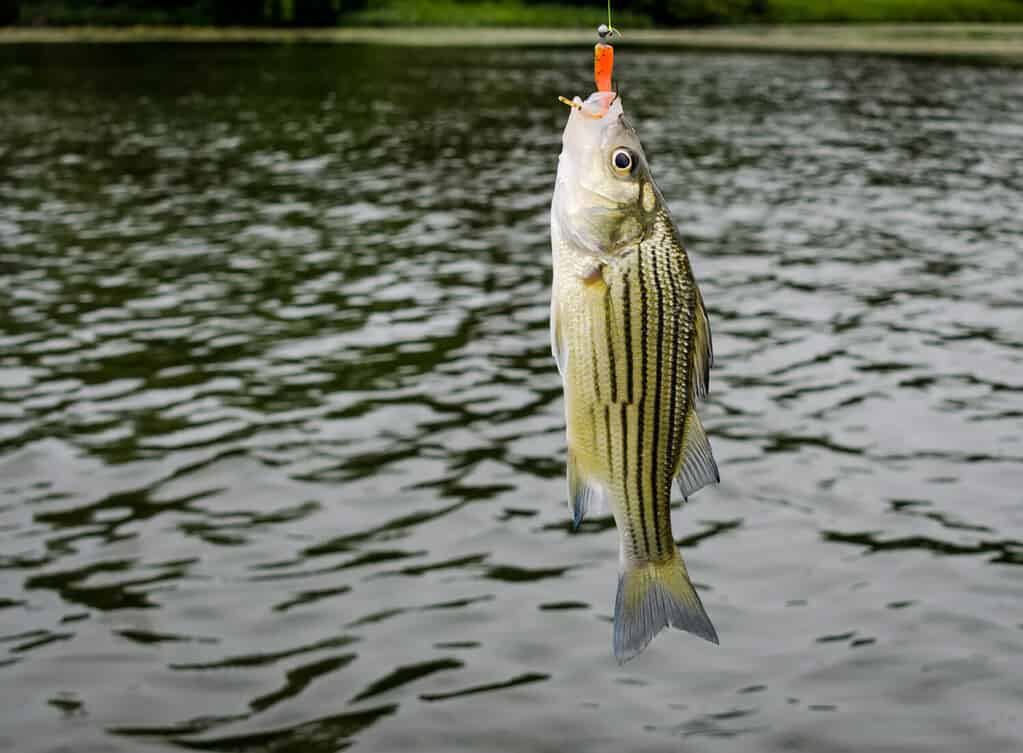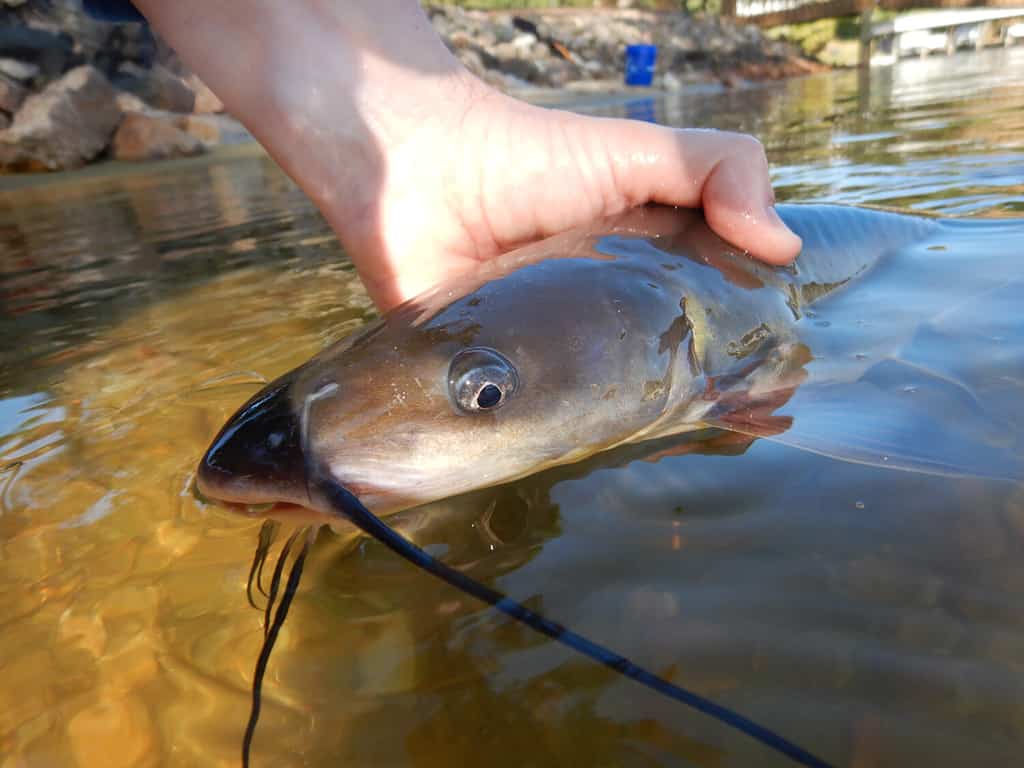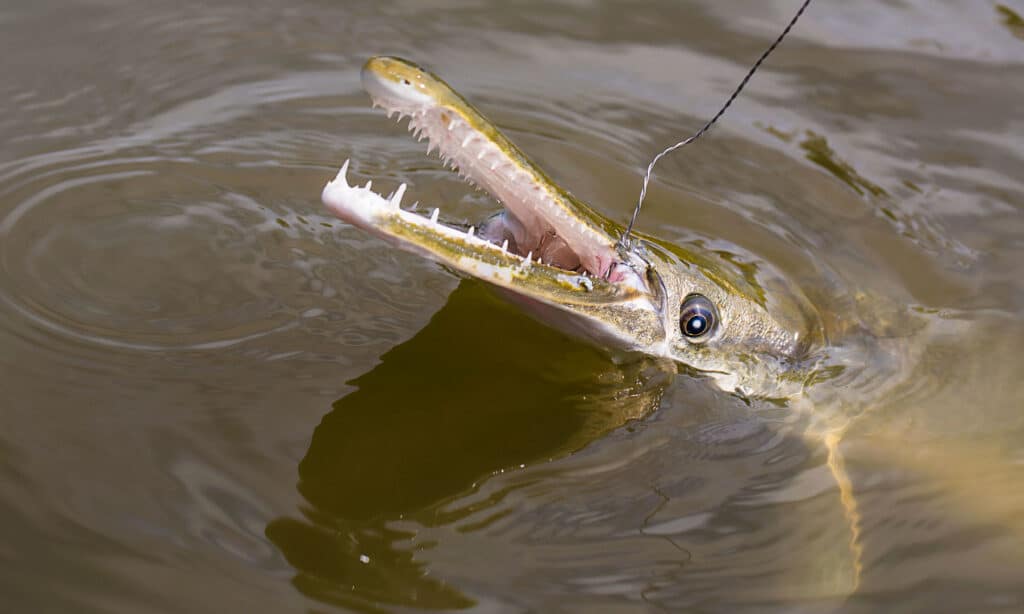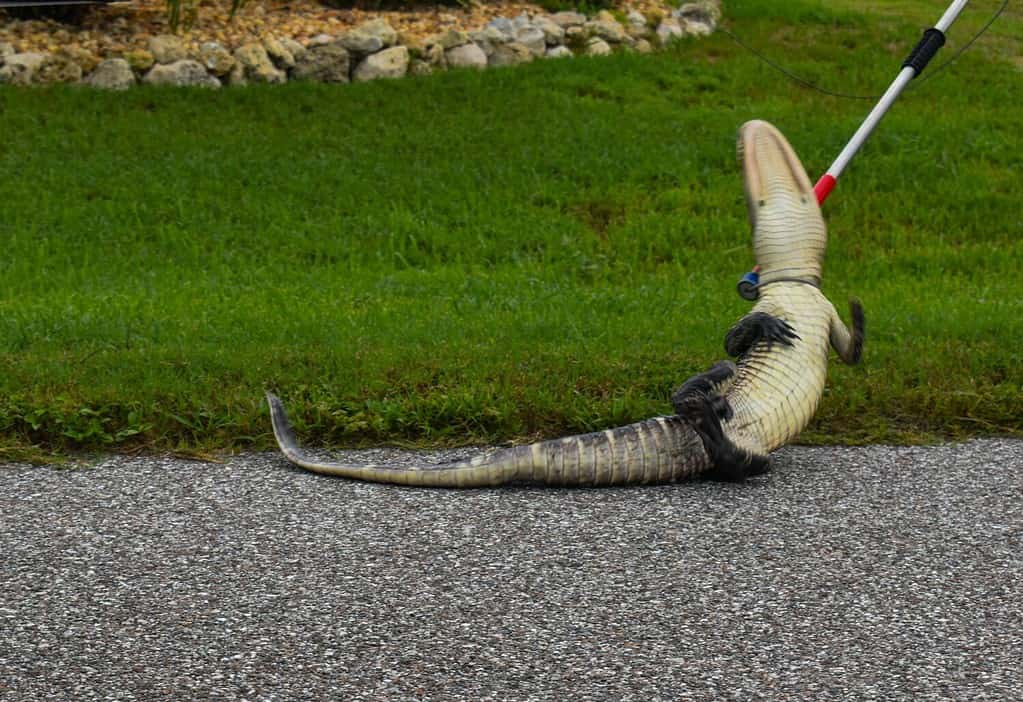Lake Allatoona is the 10th-largest lake in Georgia and home to a wide variety of fish and animals. It’s not quite as deep as Lake Lanier or Carters Lake, but at 145 maximum depth, Lake Allatoona is pretty deep.
The lake is home to a wide variety of fish and other creatures. It’s regularly stocked and is a very popular spot for both fishing and recreation. For that reason, a lot of anglers choose to fish at night when the lake is usually a bit quieter. Keep reading to learn about the many amazing fish species living inside Lake Allatoona!
Bass: Largemouth and Spotted

Look in the shallower, back-water spots to find largemouth bass. You can find them in some of the channels that come off of the lake.
©RodClementPhotography/Shutterstock.com
Lake Allatoona has many species of bass, with around 85% of them being spotted bass. Expect spotted bass to be around 12 inches in length, with older fish being up to or larger than 20 inches. Largemouth are usually a bit larger than spotted bass but the average one will only weigh in at 1.25 pounds.
Bass will go after different baits depending on what season it is. In the cooler months, use reactive baits like shallow-diving crankbaits or spinnerbaits. You’ll want to stay shallower during the winter and into April and May when spotted bass are spawning.
Largemouth bass usually stay close to the shoreline, living in spots where trees have fallen or other debris exists to create a habitat for them. You’ll want to check the shallower, backwater spots along Etowah, Allatoona Creek, and the Little River.
When it comes to spotted bass, you’ll usually find them in deeper spots than their largemouth relatives. In the warmer months, many anglers find success catching spotted bass with plastic worms and a ⅛ or ¼ ounce drop shot weight. But once late May hits and temperatures rise, you’ll want to hit deeper lake areas. There are over 36 deepwater fish attractor sites underwater that are best fished from late summer through early spring.
Bass: Striped and Hybrid

Striped bass aren’t as common as the other bass species, but you’ll able to tell them by their unique features.
©HildeAnna/Shutterstock.com
Striped bass are less common than largemouth and spotted bass, but you can definitely hook into one if you try. You’ll want to slow troll with live shad on either weighted or free-lines. The best time to catch stripers is from fall through late spring. During their spawning period in early spring, you can catch stripers in the upper reaches of Lake Allatoona. Then, head up to Etowah River in the summertime to follow their migratory path.
You can catch hybrid bass just about any time of the year, though they’re best fished in the summertime. They will usually be in deeper, cooler water then. You’ll want to try trolling with live shad in the same method for catching stripers. The best depth range to find hybrid bass is around 20 to 30 feet.
Crappie

Crappies are also called specks because the nickname’s short for speckled bass or speckled perch.
©Brandon Stinnett/Shutterstock.com
Crappies, otherwise known as specks or speckled bass, are another, smaller species in Lake Allatoona. They usually weigh around half a pound, but larger fish will be up to 2 pounds. The largest black crappie caught on Allatoona was 3 lbs 7 ozs in 2022. The largest white crappie record was broken that same year with a catch of 3 lbs 4 ozs.
In the springtime, you’ll want to fish around Kellog, Illinois, and Stamp Creeks, and the Etowah River. You can troll with jigs to cover more water or move around every couple of minutes to follow the fish. Live minnows and small jibs on bobbers are a great way to ensure you’ll get a bite. Just like bass, you’ll want to check the fish attractors for crappie during the summer. They usually congregate in cooler water and deeper areas. From fall through winter you’ll find them in warmer places, like the edges of the river channels.
Bream — Bluegill, Redear, and Redbreast Sunfish

Bluegill is the most common type of bream in Lake Allatoona.
©iStock.com/Dewitt
There are quite a few bluegills in Lake Allatoona, as well as some redear and redbreast sunfish. These fish are much smaller than bass and crappie, averaging just 5 to 7 inches in length. Redear are the largest of the three, with some catches reaching up to 9 inches long. Bream have a particular interest in live bait, so we recommend minnows or worms. You can troll with your bait on bobbers to cover more ground.
Smallmouth Buffalo

Under the right conditions, smallmouth
buffalo
can grow very large.
©TrongNguyen/iStock via Getty Images
Smallmouth buffalos are a species of large, long-lived fish that closely resemble carp but scientifically are in a different family. They live in the Etowah River and because they live for around 20 years, these fish have the opportunity to become massive. To catch them, you’ll want to use a circle hook with corn or a dough ball on the end. Some people also bowfish for this species, particularly at night.
Blue, Channel, and Flathead Catfish

Catfish like to hide in the rockier parts of the lake’s underwater terrain.
©Brookieland/Shutterstock.com
Flathead, blue, and channel catfish are widely sought after for their flavor and for frying. Blue catfish are usually the largest of the three, with the record on Lake Allatoona standing at 52 lbs 1 oz as of 2020. The angler, Aaron Churchwell, caught the whopping record-breaker on an October night. For bait, he used pieces of a 2 lb catfish that he had caught earlier during the day. The cliffs near Little River and around the bridge are great places to check for cats. They tend to stay in rockier areas, so you can find them around islands as well.
Alligator Gar and Longnose Gar

It’s clear where
alligator gars
get their unique name from!
©Jennifer White Maxwell/Shutterstock.com
You can be sure that Lake Allatoona is full of gar, because the lake record was just broken in the summer of 2023. Caleb McClure caught a 27-pound, nearly 5-foot-long longnose gar in June that dwarfs many other lake species.
While you can’t expect to catch them that big every time, most of the lake’s gars are between 3 and 4 feet long. You’ll want to use live shad or minnows on bobbers to catch these monsters.
Carp

Carp can grow pretty large because they are long-lived fish.
©Rocksweeper/Shutterstock.com
Like gar, carp also get pretty large — from around 5 to 15 pounds. You can bow fish for them or bait bottom rigs with corn, dough, or worms. They live in areas with underwater vegetation and downed trees. You’ll want to check backwaters and coves around Stamp Creek and past the nearby island.
Alligators in Lake Allatoona

People who take in exotic animals as pets cause problems for the community when they release large, friendly creatures.
©SuJo Studios/Shutterstock.com
Alligators aren’t typically found as far north as Lake Allatoona, however, they have occasionally been found in the lake. The Northwest Region Game and Fish Division pulled a four-foot gator out of Allatoona in 1989, and a six-foot gator out just a year later.
North and South Georgia can be divided by something called the Fall Line. Thousands of years ago the ocean covered most of the East Coast and the states’ land areas were much smaller. The line where the ocean met the land left a rocky border separating the northern ‘Piedmont’ region from the southern ‘Coastal Plain”.
Alligators don’t survive easily above the “Fall Line”. That’s because the winters in areas like Atlanta are too chilly for the reptiles. According to Wildlife Biologist Sid Painter, the alligator of ‘89 likely made its way to Lake Allatoona by riding ‘as a passenger in someone’s car’. People who take in exotic animals as pets often end up releasing them once they get too large to handle.
Other Animals In Lake Allatoona
You’ll find a few types of snakes in Lake Allatoona including the common water snake and the plain-bellied water snake, both of which are non-venomous. However, common water snakes closely resemble cottonmouths. Don’t get too spooked before you look closely at the slithering specimens and keep in mind that killing non-venomous snakes is illegal in Georgia.
Copperheads, one of Georgia’s six venomous snakes (out of 47 total state species), live near Lake Allatoona and around its edge. Keep an eye out while you’re walking through brush and leaves.
The photo featured at the top of this post is © Charlotte Bleijenberg/Shutterstock.com
Thank you for reading! Have some feedback for us? Contact the AZ Animals editorial team.







